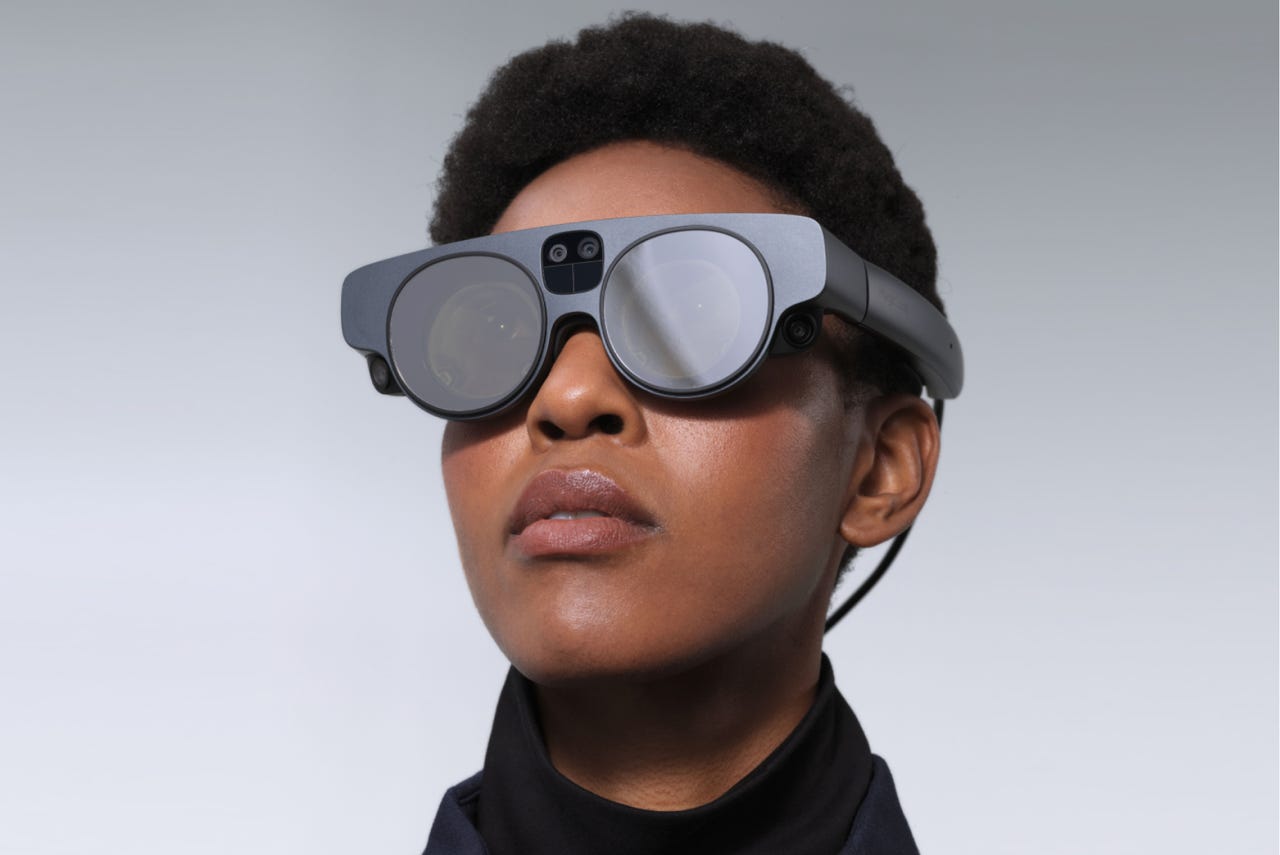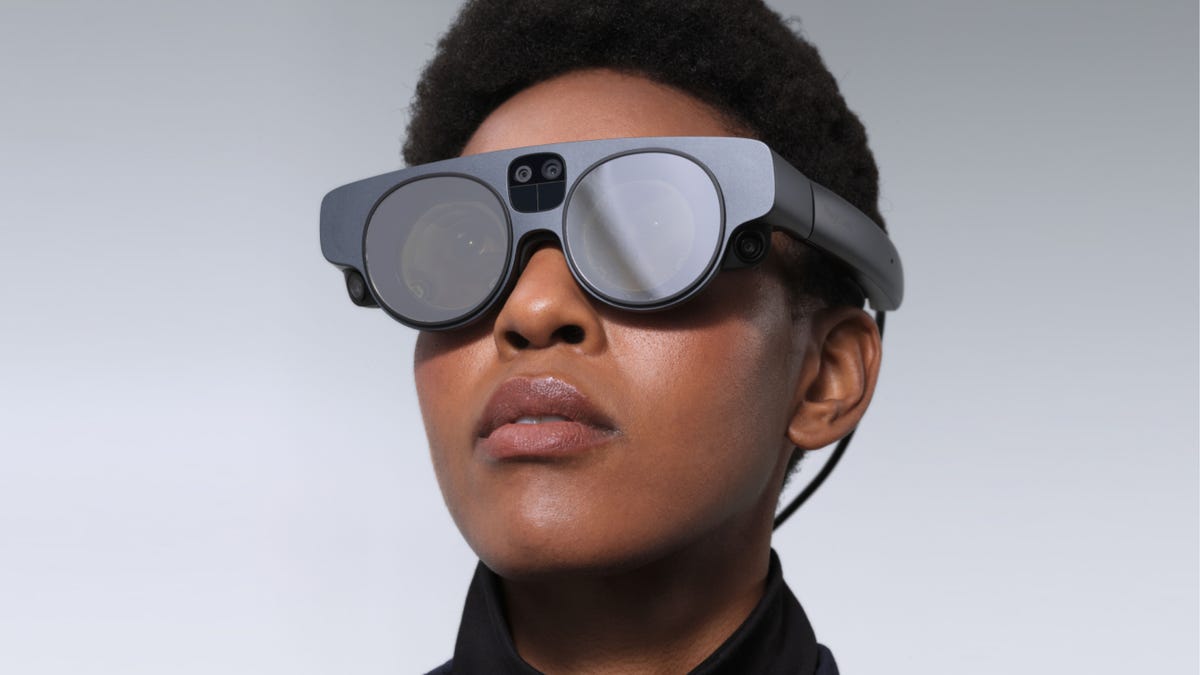Immersive AR for consumers is ‘five or so’ years away, says Magic Leap CEO

Magic Leap 2 has gotten favorable reviews as perhaps the best augmented reality headset around. CEO Peggy Johnson says a lot more still has to be done to make such devices into something consumers will want to use. Magic Leap
A viable market for consumer use of augmented reality, where simulated images are overlaid on one’s view of the world, as by goggles, is probably five years away, according to Peggy Johnson, chief executive officer of Magic Leap, the pioneering maker of AR gear.
“If I had to guess, I think, maybe, five or so years out, for the type of fully immersive augmented reality that we do,” said Johnson last week in a live Q&A forum on Zoom organized by the Collective[i] Forecast, an online, interactive discussion series that is organized by Collective[i], which bills itself as “an AI platform designed to optimize B2B sales.”
Magic Leap, which pioneered the development of glasses that let a user see rendered objects in their field of view, excited the technorati in 2018 with teaser videos, and billions in funding it received from Google.
But the first version of the product, released that year, was underwhelming. CNET called the $2,295 headset the best AR device up to that point, but also lamented “significant drawbacks to Magic Leap’s AR hardware.”
Johnson, who came aboard in August of 2020 after many years at Microsoft, and before that, chip giant Qualcomm, has redirected Magic Leap from what was mostly a consumer sensation in that first headset to a very different focus on sales to business users — “the most immersive augmented reality headset for enterprise,” as the company terms it.
“The other big thing that will happen over time is the same thing that will happen in mobile phones, silicon integration,” says Johnson, an engineer by training. “That allows you to have a very small, lightweight device, and a very power-efficient device. And we are still coming down that trajectory.” Magic Leap
The company released the second version of the headset in September, and the new device, priced nearly a thousand dollars more, $3,200, can be ordered online from multiple outlets. But the focus is to build the enterprise use of the product through partnerships and reseller channels.
Magic Leap’s second version enters a crowded market for enterprise AR as well as XR, covering devices that mix AR with VR. Microsoft’s HoloLens is among the most prominent, but there are also goggles from Vuzix and Lenovo, and Google’s Glass Enterprise 2.
The Magic Leap 2 has gotten favorable initial responses. CNET’s Scott Stein, who had been critical in 2018, wrote in March of this year that the improvements with the second version are meaningful, and collectively, “a small but key step for a company that, like many others, is aiming to solve the riddle of AR glasses.”
An early reviewer of the final product, Devindra Hardawar, wrote last month that the second version is “a significant achievement,” adding it “is easier to wear, far more powerful and it offers a dramatically larger (and taller) AR field of view than any headset we’ve seen before” and “should be easier for developers to work with, thanks to a new Android-based OS.”
However, much more basic engineering progress is necessary to achieve a consumer-friendly device, said Johnson.
“I think what is needed is a super lightweight device,” she said. “I think it needs to look something like glasses.”
The Magic Leap 2 benefits by having the processor unit as an attached device worn at the hip, something that won’t fly for consumers, noted Johnson:
Magic Leap 2.0 went far in becoming lighter, it’s about 20% lighter, it’s about half the size, so we really tightened up the metrics, which has been helpful for all day use for somebody in an industrial setting, or even a doctor during a long surgery. But, still, for walking around, I think the device is not quite what a consumer would put up with for a full day. I think we really need to be in that glasses category.
Magic Leap has been re-oriented toward enterprise use cases. Here, a group visualize a wildfire scene with images of terrain and stats overlaid on their view of the world. Magic Leap
To make such a compact device runs into the limits of current electronics, especially batteries:
It’s hard to get down to that size. The battery is a constraint. The processor itself — right now, we have the processor separate from the headset; that’s how we make the headset so light, it kind of hangs off your waistband or your pocket. It’s a little bit heavier, it can be warm because it’s a processor. We just don’t think that’s wise to build that into headset right now. It’s uncomfortable. There are others on the market who have done that, and that’s the biggest complaint: it’s clunky, it’s hot, it’s heavy. And so, we’ve got to solve all of that in order to get these onto consumers.
Johnson, an engineer by training, said the continued path of silicon integration in chips will help:
The other big thing that will happen over time is the same thing that will happen in mobile phones, silicon integration. The CPU that runs our mobile phones used to be a lot of components, and it used to be bigger. And my old company, Qualcomm, puts more and more features into that chip. That allows you to have a very small, lightweight device, and a very power-efficient device. And we are still coming down that trajectory.
There are already a few devices on the market, said Johnson, “that are more of a heads-up display.”
Those kinds of devices, while not immersive like the Magic Leap, “might solve an anesthesiologist’s problem — like, I just want to see the vitals in front of my eyes,” she said.
Also: The 4 best AR glasses: Pro-level AR and XR headsets
“That’s really easy to do, that’s just putting a little display in front of your field of view, and not blocking anything else. That is something that can happen today.”
Johnson reiterated, “But for that fully immersive AR experience that will really be a tool for consumers, I think it’s going to be several years, probably five or so.”





Pingback: weed delivery Toronto
Pingback: best place to buy magic mushroom spores
Pingback: https://analytics.rrr.org.au/event?target=https://devs.ng/bet3000-nigeria-review/
Pingback: บับเบิ้ล กันกระแทก